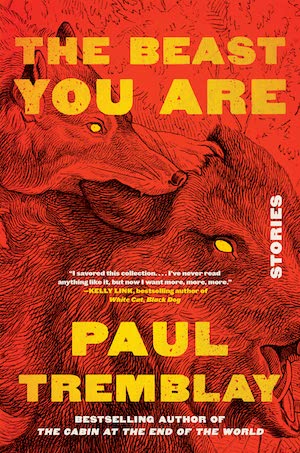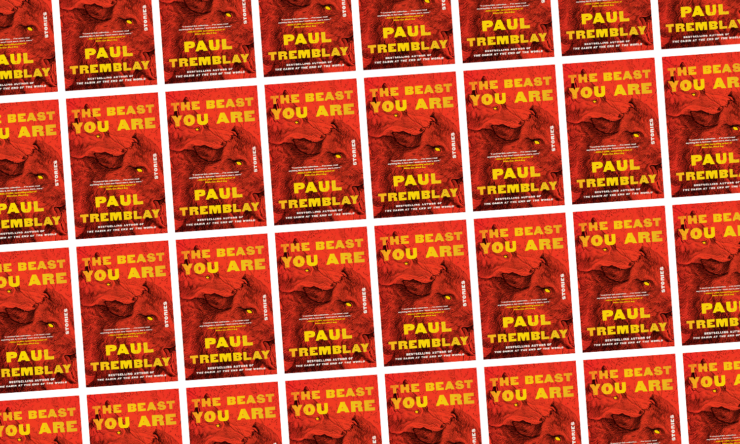To read Paul Tremblay is to visit the place where three distinctive creative impulses converge. The first of these is an embrace of formal experimentation. Tremblay’s most recent novel The Pallbearers Club, for example, was told via a found document and by the commentary of another character on said document. The second is narrative ambiguity—it’s possible to read the aforementioned novel, as well as A Head Full of Ghosts and Disappearance at Devil’s Rock, as having no supernatural elements whatsoever, only flawed people struggling with events they can’t fully process.
The last component of Tremblay’s fiction, though, is an all-encompassing, pit-of-your-stomach dread. Whether or not you believe the horrors in his fiction to be supernatural in origin, they are unquestionably horrors—and Tremblay’s process of coaxing them out and revealing their full scope is equally suited for the short form and the long form.
The Beast You Are is his last collection. It’s subtitled “Stories,” but it could just as easily have “A Novella and Stories” on its cover; the work that gives it its title makes up nearly half of the book. (Also, there’s the matter of the talking animals; oh yes. We’ll get there soon enough.) And, sure enough, several of the stories within utilize unconventional structures, often to memorable effect.
Buy the Book


The Beast You Are
One story, “The Blog at the End of the World,” is told in reverse chronological order; it’s in the found-document mode, in this case a blog being written by someone documenting what they believe to be a slow apocalypse. In this case, you are going to want to read the comments; they’re a central part of the narrative, and hint at even more unsettling directions for the story. It’s not easy to pull off something like this—Dennis Cooper’s novel The Sluts is one of a handful of examples that have worked for me—but Tremblay makes it click.
There’s also “The Postal Zone: The Possession Edition,” a short story as a series of letters to the editor. This should not be confused with the magnificently-titled “Howard Sturgis and the Letters and the Van and What He Found When He Went Back to His House,” in which a mysterious exchange of letters plays a significant role on the story, but which is not told solely through letters. In the latter story, notably, Tremblay skirts the line between horror and capital-w Weird fiction, in that the plot involves both a seemingly impossible exchange of letters and a seemingly impossible piece of technology.
Readers familiar with Tremblay’s penchant for literary allusions may take note of two of the collection’s highlights. There’s “House of Windows,” which shares a title with an excellent John Langan novel but ventures in a very different direction—think strange buildings showing up where they didn’t exist before. And “The Party,” which first appeared in the Ellen Datlow-edited anthology When Things Get Dark: Stories Inspired by Shirley Jackson, follows its characters as they arrive at a party with a unique theme. Here, Tremblay taps into the same engine that underlies much of Jackson’s work, namely the parallel tension of awkwardness at a social function and the sense that something may be deeply wrong with the world.
I’m sure that at this point, you’re probably nodding your head and saying something like, “Yes, that’s all well and good, but didn’t he say something about talking animals before?” Yes, yes he did.
In the Story Notes that conclude this book, Tremblay writes of his affection for films like Watership Down and The Secret of NIMH and his long-running “want to write an anthropomorphic animal story.” And that’s what we get here. Also, it’s told in free verse. Also, it spans decades. Besides the films Tremblay mentions, there’s also, perhaps, a bit of BoJack Horseman in here—the animals have a society that’s essentially human, and their lifespans match up with those of humans. There’s one big difference, though: There’s a ritual sacrifice to a creature held regularly, in which a monstrous being is offered three residents of the town, to do with as it pleases.
“The Beast You Are” follows two of them–Magg, a dog, and Mereth, a cat–whose status as survivors of the monster’s attack make them “sisters not by their own blood/ but by someone else’s.” There’s more to it as well; the novella begins with a declaration that places all of this in a mythic context. “There were other/ First Ages/ before this one,” Tremblay writes, and those words loom over all that follows.
Could this story work in a different context, with humans instead of walking, talking animals? Maybe. But there’s a moment in there where one character moves on all fours, with an accompanying reaction of shock from those who witness it, that makes Tremblay’s decision to go in the direction that he did work. Telling the story in free verse doesn’t hurt, either; it adds to that sense that this is happening somewhere similar to our world, but not.
But the thing is: It works. (Maybe it works especially well for me because of my fondness for the board game Root, which — like Tremblay’s novella — prominently features a menacing cult.) “The Beast You Are” follows Magg and Mereth over the years and decades, as their lives take wildly different paths; the whole thing is like nothing I’ve read before. Nearly all of Tremblay’s books have differed markedly from what’s come before. That’s also true here, but The Beast You Are also embodies that ever-shifting quality of his work over the course of its pages.
The Beast You Are is published by William Morrow.
 Tobias Carroll is the managing editor of Vol.1 Brooklyn. He is the author of the short story collection Transitory (Civil Coping Mechanisms) and the novel Reel (Rare Bird Books).
Tobias Carroll is the managing editor of Vol.1 Brooklyn. He is the author of the short story collection Transitory (Civil Coping Mechanisms) and the novel Reel (Rare Bird Books).










